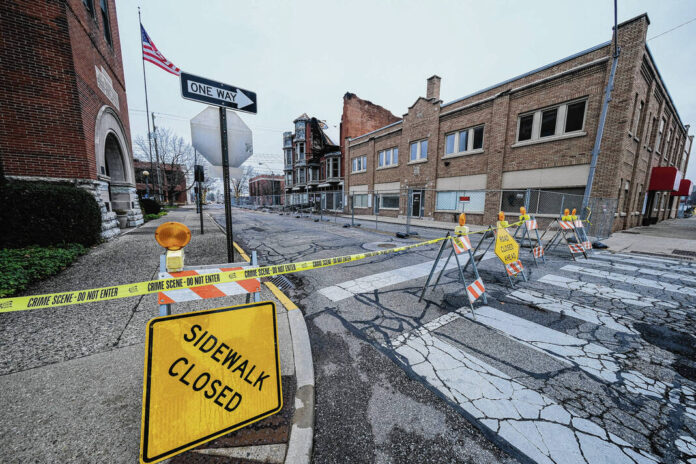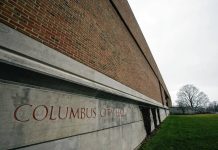
Mike Wolanin | The Republic Barricades and caution tape close off Fifth Street due a fire that destroyed the Irwin Block building in Columbus, Ind., Friday, Dec. 9, 2022.
More than a week after a fire destroyed a treasured historical building in downtown Columbus, the cause of the blaze is still unknown.
The fire, which broke out late Dec. 3, ravaged a commercial building on the 400 block of Fifth Street that has been known for generations of Columbus residents as the “Irwin Block” building, resulting in a large portion of the building’s third story façade collapsing onto the sidewalk and street.
The building is believed to be at risk of collapse and Columbus firefighters have said that it is likely the building will need to be demolished. City officials condemned the building last week, but no demolition permits for the property had been filed with Bartholomew County Code Enforcement as of mid-day Monday, officials said.
Local and state fire investigators began investigating the cause of the blaze that same weekend, and the investigation was still ongoing as of Monday, said Columbus Fire Department spokesman Capt. Mike Wilson.
“The investigators have been working with all the occupants, and then trying to gather as much information as possible in terms of the businesses that occupied the building. And then they’re also working with insurance companies at this time as well. At this point, there has been no cause determined, and it could remain under investigation for a period of time,” he said.
Last week, local officials confirmed that the building did not have a sprinkler system but was not required to have one due to the age of the building, how it was being used, its occupancy, square footage, among other criteria. The building is likely around 129 years old, said Bartholomew County Historian Tami Stone Iorio.
“It would have predated the requirement for a fire sprinkler system,” said Columbus Fire Inspector Troy Todd.
However, the building next door at 440 Fifth St., which currently houses the Columbus Area Chamber of Commerce and was also impacted by the fire, did have a sprinkler system, Todd said.
State officials told The Republic that many historical buildings in Indiana may not be required to have sprinkler systems.
“Building codes are put into place in a specific year,” said Anna Shei, spokesperson for the Indiana Department of Homeland Security, which includes the Indiana State Fire Marshal’s Office. “Buildings built before the year the code was enacted are not required to update to the new code. Buildings built after the year the code was enacted are required to stick to the latest code. A number of historical buildings may not be required to have sprinklers systems because the building was built before sprinkler systems were enforced.”
“A number of factors can come into play that would require historical buildings to install a sprinkler system,” Shei added. “Those factors could include a remodel of the building, a change in use, a change in occupancy, etc.”
The last time that city fire inspectors inspected the office located at 422 Fifth St. in the Irwin Block building was on Oct. 11, 2018, according to city records. No violations of the fire code were found during the inspection, though that inspection appeared to only include the Arnholt & Spraggs Law Office.
Wilson said commercial properties that contain multiple businesses are generally inspected on an “individual business basis,” meaning that each individual business is inspected separately.
The last inspection of the building by Bartholomew County Code Enforcement was in 2012, when an office was reconnected to an electrical utility, county records show.
County inspectors in those situations do not check the electrical wiring of the entire building but rather “look to make sure everything looked good in the meter base and the panel and (that) there were no issues there,” Bartholomew County Chief Code Enforcement Officer Michelle Cox.
“We have to take off the panel and make sure all the wiring looks good inside that panel, that the breakers look good (and that) it looks safe,” Cox said.
But inspecting the electrical system beyond that would likely the responsibility of city fire inspectors, Cox said.
Currently, the city has two fire inspectors, though they are unable to inspect every commercial property each year “just because the amount of buildings we have and the amount of inspectors that we have,” Todd said, who also said the city could “probably use two additional (inspectors) realistically.”
Todd said there are about 2,500 businesses within the Columbus city limits, ranging in size to a few hundred square feet to Cummins Columbus Engine Plant, which covers about 40 acres.
“…They would like us, according to code, to be able to inspect (the buildings) annually,” Todd said. “But what we run into is if you inspect a building and then if there are violations, then you have to go back and see if those violations are corrected. If they aren’t, then you go back. We continue to go back and work with the owner or the building representative to see that those violations are corrected.”
Wilson said city fire inspectors try to inspect every building each year. If that is not possible, inspectors follow suggestions in the fire code on how often to inspect buildings based on how high of a risk the occupancy poses. High-hazard facilities such as health care facilities, hotels, schools, among others, are generally inspected annually, while more lower-hazard facilities may not be inspected every year.
“We have an inspection division that is two members deep,” Wilson said. “…In the event that we were able to add to that inspection division, we could certainly cover more space and inspect more buildings.”
The Dec. 3 fire, however, was not the first fire to impact the Irwin Block building. In 1928, a fire “gutted the upper part of the east side” of the building and left it roofless, according to The Republic’s coverage at the time.
The 1928 fire started on the third floor of the building, which was unoccupied at the time, and “was confined to the upper part of the building and to the east side.” The fire chief at the time said, “the fire resulted from defective wiring in a closet on the third floor.”




